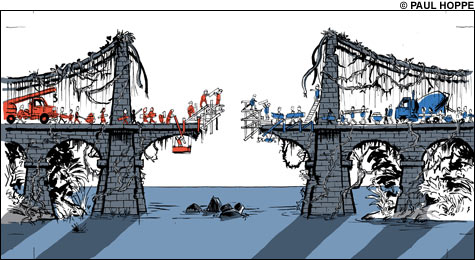Obama Brings Focus Back to Minneapolis Bridge Collapse, Media Blunders the Story
8:59 AM PDT on April 21, 2011

(Marybeth Miceli is the President of Miceli Infrastructure Consulting, LLC. She is a bridge testing and assessment specialist and materials scientist with a background in Nondestructive Testing/Evaluation. She has just completed a 3-year term on the Board of Directors for the American Society for Nondestructive Testing (ASNT), who named her "Young NDT Professional of the Year" in 2004. Miceli is married to L.A. Streetsblog Editor Damien Newton.)
We can thank President Obama for calling attention once again to the tragic bridge collapse of the I-35 W Bridge outside Minneapolis in 2007. In a recent speech , regarding the republican spending bill, he criticizes the GOP’s infrastructure spending cuts, tying together the collapse with aging infrastructure and our lack of spending in the transportation arena. The critics in the media have decided to jump on this, waving the National Transportation Safety Board (NTSB) report saying the 2007 collapse of the I-35 highway bridge just outside of Minneapolis was caused by a design flaw.
Unsurprisingly, the media continues to not do their homework, particularly when it comes to transportation infrastructure. How many of them reporting on this story (or even those who reported on the original collapse) actually read the report?
The President is 100% correct to draw this association between lack of funding and the collapse. Though the “root cause” of the collapse was the gusset plate design flaw, there were many contributing factors to the collapse such as the construction equipment and materials being placed on the exact weak joint. But there is so much more to the “perfect storm” that caused the collapse. If any one of the factors had been avoided, the tragic collapse that took the lives of 13 would likely have been averted.
Cutting funding for transportation infrastructure, inspection, and repair only make it more likely that the conditions that caused this “storm” could happen again.
Two of the main contributing factors were:
1. The buckling gusset plates were missed during normal bridge inspections though photographed back in June of 2003, 4 full years before the collapse. Normal bridge inspections consist of visual inspection because we don’t prioritize the funds to perform more in depth inspections unless engineers already “see” a problem. As our structures get older, this method is only going to become more and more obsolete and ineffective. Imagine that your doctor just looks at you during an exam and only does other tests if they see something wrong with you on the outside. I would imagine you’d be in pretty bad shape by the time other tests were ordered. Imagine how ineffectual this method would be as you continue to age.
2. The I-35 Bridge had known problems before the collapse, literally hundreds of fatigue cracks. These cracks indicate that the bridge is not behaving the way it was designed to behave, nor how engineers think it should be behaving. MNDOT did not have the proper funds to do the structural health monitoring necessary to monitor the condition of this aging bridge and figure out the root of the problem – why those cracks were initiating and propagating.
If proper funding, and collaboration with bridge experts (which also takes proper funding), had been available for this aging structure, the problem gusset plates likely would have been found and construction on the deck would not have been allowed – collapse averted.
That’s where the bad news is. The longer we continue to argue about infrastructure spending (which incidentally used to be a Republican issue, not a Democratic one) the older our structures are getting and the worse the problem is getting. It is not going away. And just as we get older and need to see the doctor more often and get more tests on our aging bodies, these structures are going to require more and more attention.
More spending by itself is not the answer. We do indeed need more funding because we are embarrassingly behind where we need to be, but the increase in spending needs to be coupled with legislation and specifications that call out using technology to make better, more cost effective repair, maintenance, and life extension decision making for bridges. Without this second piece, we will never catch up.
But in the mean time, let’s stop finger pointing about who is more “wrong” on infrastructure spending – both parties are responsible for the sorry state of affairs of our bridges over decades. We need to pool together the right experts to work with the legislators to come up with viable short, mid- and long-term solutions that address this crisis. Otherwise we will be still arguing about this when, not if, the next bridge collapses.
Stay in touch
Sign up for our free newsletter
More from Streetsblog Los Angeles
Automated Enforcement Coming Soon to a Bus Lane Near You
Metro is already installing and testing on-bus cameras. Soon comes outreach, then warning tickets. Wilshire/5th/6th and La Brea will be the first bus routes in the bus lane enforcement program.
Metro Looks to Approve Torrance C Line Extension Alignment
Selecting the relatively low-cost hybrid alternative should help the oft-delayed South Bay C Line extension move a step closer to reality





